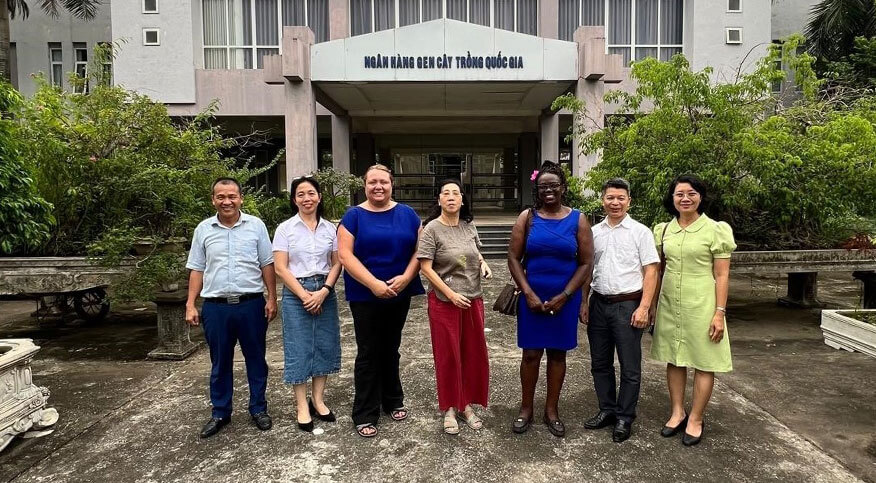
WEST LAFAYETTE, Ind. — LASER PULSE, a program run by the Global Development & Innovation (GDI) division of the Purdue Applied Research Institute (PARI), continues to deliver a unique mechanism that enables the United States Agency for International Development (USAID) to more effectively tap into novel, cutting-edge global development research happening in higher education.
The Long-term Assistance and Services for Research (LASER) Partners for University-Led Solutions Engine (PULSE) is a 10-year, $70 million PARI-led consortium that provides research-driven solutions in various development sectors across USAID partner countries. Awarded to Purdue University in 2018, LASER PULSE collaborates with USAID to identify research needs for critical development challenges, connect academics with local practitioners and manage the progress of funded research projects.
Founded in 2021 as part of Purdue’s Next Moves, PARI was created to sustain programs such as LASER PULSE and maximize the role the university and its researchers can play in addressing critical global challenges. Since its transfer to PARI in 2023, LASER PULSE has succeeded in reducing startup costs for development projects and increasing outreach efforts to USAID missions, bureaus and independent offices, garnering additional support and funding for research teams. So far, the program has 57 projects in 27 USAID partner countries ranging from $50,000 to $5.12 million, with five projects launching in just the last month alone.
“We are excited that PARI has been able to sustain the important work of LASER PULSE initiated by Purdue,” said John Glover, GDI executive director. “We look forward to continuing to engage our global network of researchers to solve these important global challenges.”
What makes LASER PULSE unique is its approach to building teams of academics and practitioners who collaboratively research a development challenge. LASER PULSE draws nearly 4,000 collaborators from more than 80 countries. Two-thirds of these collaborators hold traditional university researcher positions while the rest are practitioners, such as nongovernment organization directors, civil-society leaders or entrepreneurs. LASER PULSE intentionally brings together stakeholders from the outset to identify what new research is needed, and to what end, to solve a specific development challenge.
Through this model, research translation is an integral component across the entire research process, from forming the research team to producing and disseminating the results. In other words, there’s no research for research’s sake; all findings must be translated into a tangible product, such as a webinar, training manual or tool kit, that positively impacts a development challenge.
“We see policymakers eager to be a part of research translation from the outset, not just at the end when we as academics want to figure out how our findings can apply,” said Jennifer DeBoer, director of practice for education and youth at GDI and associate professor of engineering education at Purdue. “For example, we had a productive discussion with colleagues in the USAID Malawi mission, who jumped at the chance to be part of the LASER PULSE approach. They immediately said, ‘We need new research on the issue of lead exposure in schools.’ So there’s the translated research need for a development challenge, and that’s how our process kicks off.”
Several projects managed through the LASER PULSE mechanism have prompted notable program and policy changes:
- A project on decentralized water resource circulation in Vietnam, led by researchers at Hanoi University of Science and Technology, contributed to the signing of a new law that addresses water recycling.
- A team led by Gerald Shively, associate dean and director of International Programs in Agriculture at Purdue, helped to complete the first national nutrition research agenda in Laos to combat malnutrition.
- Researchers from Alabama A&M University, University of Rwanda and University of Global Health Equity developed a training curriculum for dairy workers to improve the quality and safety of milk in Rwanda.
The LASER PULSE team makes a concerted effort to connect with its project teams. This summer, Technical Director Betty Bugusu and Program Director Suzi Cyr traveled to Laos and Vietnam to meet with missions and project teams, establishing connections and promoting the program’s capabilities in development research.
“By the time we departed Laos, we had already engaged in a follow-up conversation with a potential partner in Vietnam, thanks to a recommendation from a contact at the Laos mission,” Cyr said. “While not every discussion leads to new work, we are seeing a significant increase in requests from USAID, largely attributable to our comprehensive outreach efforts.”
LASER PULSE is constantly seeking to expand its network of researchers and practitioners. Those interested in joining should visit the program’s website to explore current projects and upcoming funding opportunities.
About Purdue University
Purdue University is a public research institution demonstrating excellence at scale. Ranked among top 10 public universities and with two colleges in the top four in the United States, Purdue discovers and disseminates knowledge with a quality and at a scale second to none. More than 105,000 students study at Purdue across modalities and locations, including nearly 50,000 in person on the West Lafayette campus. Committed to affordability and accessibility, Purdue’s main campus has frozen tuition 13 years in a row. See how Purdue never stops in the persistent pursuit of the next giant leap — including its first comprehensive urban campus in Indianapolis, the Mitch Daniels School of Business, Purdue Computes and the One Health initiative — at https://www.purdue.edu/president/strategic-initiatives.
Media contact: Lindsey Macdonald, macdonl@purdue.edu